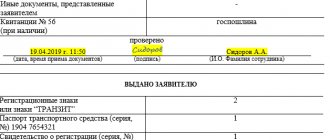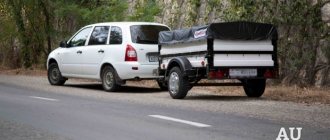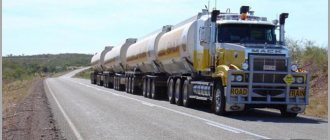A waybill
is the main primary document for recording the driver’s work, mileage, and vehicle route, issued daily to vehicle drivers.
The waybill form refers to the primary documents used in the process of accounting for cargo transportation. The waybill together with the bill of lading form (TTN) are documents characterizing the work of the driver and the vehicle. Both documents serve as the basis for calculating and paying wages to the driver, as well as for calculating the cost of goods transportation services. In 1997, two forms were approved, which are still used for the operation of freight vehicles in Russia.
Why do you need a waybill?
Waybill form 4-c is used for cargo transportation based on piecework wages (the driver completed the trip - handed in the waybill). Waybill form 4-p is used when a temporary tariff is applied. As a rule, this form takes into account the driver’s work during one work shift (one day). At the same time, he can make several flights of the same type for one customer, or two flights for different customers.
The waybill consists of the main part and a tear-off coupon. The tear-off coupon of the form is filled out directly by the customer. The data specified in it serves as the basis for issuing an invoice for work performed by the carrier. The tear-off coupon is an integral part of the invoice and serves as confirmation of the accrued amount for the services of the cargo carrier.
The main part of the waybill form is an accounting document and remains with the carrier. This part of the waybill must contain duplicate data on the time during which the cargo carrier’s vehicle was used and the length of the cargo delivery route. It also reflects data on the forced downtime of the vehicle, the need for additional operation of the vehicle engine and the implementation of work related to the use of equipment installed on the vehicle. It is these data that serve as the basis for calculating the operation of a given vehicle.
If time-based payment is assumed for the road transportation of goods, then the number of each consignment note, which is attached to the waybill, is indicated on the waybill. A copy of the waybill (BW), attached to the waybill form, serves as confirmation of the work performed. Upon completion of the work, records are made and an entry is made in the waybill register, and the total total (in tons) of transported cargo is calculated. Based on the aggregate indicators, the hours of use of the vehicle and the driver’s salary are calculated.
Before the driver starts work, the main part of the waybill form must be filled out by the cargo transportation dispatcher, or the person replacing him. Subsequent entries in the waybill are made by employees of the cargo carrier organization, as well as by the customer (or his representative). The driver does not have to make any entries in the waybill. He signs the waybill only when he accepts the car for work and returns it at the end of the shift. The driver receives waybills from the dispatcher at the beginning of the work shift, and their receipt is certified by a signature. At the end of the work shift, he is required to hand over the waybill. This document is issued only for one work shift or work day. The driver can receive a new waybill only after he hands over the old one to the dispatcher and thus closes the working day.
Procedure for using the waybill
The mandatory form of waybill is not provided for by law. The company has the right to independently develop the form based on its own needs.
However, there are two types: standard interindustry form 4c and form 4-P, which an enterprise can use when preparing primary documents for transport operations.
They differ in the way payment for transportation services is calculated. Truck waybill form 4-c is used when piecework indicators are used for calculation, the second form is used with a time-based payment system.
As an accompanying document, in addition to the voucher, the driver is given a consignment note for the cargo.
The waybill for a truck is issued by responsible persons in the company for one day or shift. The mechanic, the pre-trip medical examiner, the dispatcher, the fuel attendant, and the driver of the car must put their marks in it.
How to correctly make entries in the travel form
The order of filling out the columns of the waybill is strictly regulated. Filling occurs as follows:
- The date (day, month and year) is indicated under the name of the document, which must correspond to the date entered in the registration journal for the issuance of travel documents;
- Next comes a line in which the work code should be indicated. It is this code that serves as the basis for calculations and payment of wages to the driver;
- The columns “Brigade” and “Column” reflect the numbers of the vehicle fleet units to which the truck or the driver himself is assigned;
- The “Vehicle Data” column must contain data on the make of the car, its registration numbers (state and garage);
- Lines containing official and personal information about the driver must be filled in with the following data. This includes the driver’s surname and initials, his license number, his personnel number assigned according to the organization’s staffing table, as well as the driver’s class;
- If transportation of cargo requires a license, then you must fill out the column with information about the license card. This column indicates the series and number of the card, as well as its type. By type, license cards are divided into limited and standard;
- The “Trailers” column must contain the state and garage number of the semitrailer or trailer, as well as the brand, if the use of these means is necessary for the cargo transportation process. If trailers are expected to be replaced during cargo transportation, then their numbers and brands are entered directly on the spot;
- The column “Accompanying persons” must contain information about the persons who accompany the driver when transporting cargo. These persons can be trainees, forwarders, loaders. This column contains the surname and initials of employees, as well as the documents on the basis of which they carry out their work;
- The column “Work of the driver and the vehicle” must contain information about the time of departure of the vehicle from the territory of the motor transport enterprise and the time of its return to the territory of the vehicle fleet;
- In the column “Assignment to the driver”, the freight dispatcher or other person enters the address of the customer’s location, at whose disposal the driver with the vehicle is placed;
- The column “At whose disposal” requires the customer to indicate the person with whom the driver will specifically contact while performing the work. Often this is the customer himself, but this person can be a trusted representative of the client. The authorized person carries out his duties on the basis of a power of attorney. It is best to attach a copy of the power of attorney to documents (waybills and waybills);
- The “Arrival time” line must contain data, indicated in hours and minutes, about the time of arrival of the vehicle at the customer’s location to perform one-time work. If the services under the contract involve the completion of work over several days, then the time is recorded in this column according to the schedule specified in the contract;
- The address columns for the loading and unloading point (No. 20-21) must reflect the actual addresses of the point of loading of goods and the point of delivery (unloading) of goods;
- The line “Name of cargo” contains the full name of the goods intended for transportation;
- The line "Number of trips with cargo" should reflect the required number of trips required to complete a particular task. The task is determined in the application or in a single order;
- The “Distance” column contains data on the length of the route. Kilometers can be determined from data from road organizations or a map of the city (region). You can also use data from previous cargo transportation. Kilometers can be calculated on any transport exchange operating on the Internet, for example ATI.SU. As a rule, the data provided by transport exchanges is quite accurate, and the mileage calculation service is absolutely free;
- The column “Transport tons” contains data on the amount of cargo in tons that needs to be transported.
Any changes to the waybill regarding the driver’s assignment may be made only by an employee of the motor transport organization that owns the vehicle. In case of agreement between the parties (carrier and client), this can be done by a person authorized by the customer or by the customer himself.
On the front side of the waybill form there is a column “Issue fuel”, which indicates the amount of fuel required for the operation of the vehicle. The amount of fuel required is entered in the column in words, taking into account unused fuel over the past day. The completely filled out sheet by the dispatcher is certified by his signature. Thus, the dispatcher certifies the correctness of completion and reliability of all entered data, including the fact that the driver has a driver’s license.
Electronic waybill (EPL)
This October, an experiment is being conducted on the use of electronic waybills. Let us remind you that this pilot project took place in six regions. It is planned that from the end of October part of the system will begin to work, but in the mode of analysis and refinement.
The result, according to the Ministry of Transport, should be the transfer of paper documentation completely into digital format.
Accordingly, transportation participants save time and money, and it is easier for the traffic police and the Federal Tax Service to work.
The final decision on whether the EPL will be put into operation remains open.
We talk about this in more detail in the article Superservice 22 - online transportation.
Author: Oleg Severin
A truck waybill is the primary document on the basis of which the accounting records of a company specializing in transportation or using vehicles for other own purposes are maintained. Read more about the form and rules for filling out the document below.
How to fill out a waybill before leaving the garage
There are not many columns to be filled out in this part of the sheet. Following the recommendations, filling out this form is often quite simple.
- The columns related to the section “Fuel Movement” are filled out by the tanker or fuel and lubricants technician. These columns record data on the fuel actually received to carry out the work;
- The front side of the travel document form must contain a note about the medical examination. A medical examination is a mandatory procedure before the start of cargo transportation work. Only an officially authorized person with a medical education performs a medical examination and fills out the necessary columns of the waybill. The purpose of the medical examination is to determine the driver’s health status and his ability to drive a vehicle;
- Before the vehicle leaves for the line, a specialist from the technical control department or checkpoint must record data from the car’s speedometer and enter this information in the “Speedometer readings” column. The column is located in the “Car and Driver Operation” section;
- These same specialists reflect the time the car left the line. The time is recorded in the “Actual time” column. It is possible to enter data either manually or using a stamp. Sequence of data indication: date, month, hours and minutes;
- Another column related to the “Fuel Movement” section reflects the remaining fuel in the vehicle’s tanks when leaving the route. This data is recorded by the fuel and lubricants mechanic in column No. 12 of the waybill;
- The waybill form contains lines that reflect the actual condition of the vehicle (its suitability for work, technical notes and recommendations). This section is filled out by a quality control mechanic and indicates the vehicle’s readiness for work, and also serves as permission for the driver to leave. This section is certified by both the mechanic and the driver’s personal signature.
How to fill out a waybill on the route
Consider the procedure for filling out the travel form using the example of form No. 4-c.
- Column No. 27 contains information about the numbers of all flights made. This is necessary for subsequent sorting of all attached delivery notes;
- The next column must contain the numbers of all waybills attached to the waybill;
- Data on the date and time of provision of the waybill form to the consignee or sender are entered in columns No. 28-30. This occurs if a checkpoint is provided on the territory of the customer or consignee. Otherwise, these columns are not filled in, and the data is entered in the corresponding lines of the consignment note;
- Columns No. 39-40 contain the full name of the shipping organization. Data about the shipper (name and details) are certified by the signature of the shipper or an authorized representative, and also certified by a seal;
- If any unforeseen circumstances arise that cause downtime, in this case the line “Downtime on the line” is filled in. The data is entered by the appropriate specialist (technical assistance employee) or any other authorized person. The column must indicate the reasons for the downtime, the date and the exact time period during which the vehicle was idle. Data on downtime is certified by the signatures of the persons who filled out this column;
- On the front side of the waybill there is a section “Special notes”. It contains data that is not included in the waybill: comments and refusals of the customer to carry out work or vehicles, comments from traffic police officers and road service specialists.
Form
Just a few years ago, it was necessary to use a unified form to issue a waybill. But in 2013 this rule was canceled. Thus, organizations are allowed to develop their own forms. Naturally, they must be indicated in the accounting documentation. In addition, such forms must contain mandatory information relating to any specific transportation.
However, conventional forms that were previously considered mandatory can also be used today. Many companies take advantage of this right. After all, these forms meet all the necessary requirements; important points are already present here. These forms are clear and familiar.
There are three forms that can be used to issue travel vouchers:
- 4-P is used in situations where time-based wages are paid;
- 4-C is used for piecework wages;
- 4-M this form is appropriate in situations where freight transportation is intercity in nature.
It is worth noting that these forms are almost identical, and there are no fundamental differences in filling them out. In the absence of any details that are considered mandatory for “vouchers”, they can be additionally entered into the specified forms.
( Video : “How to fill out a truck waybill”)
New rules for filling out a truck waybill
The waybill is an extremely important document, both for the driver and for the organization itself.
It refers to primary accounting documentation, and is the basis for various accounting calculations: write-off of fuel and lubricants, payroll, etc. The rules for maintaining this document are periodically updated. This is done to ensure that all necessary calculations are made as accurately as possible. So, it is worth mentioning the next innovations that came into force in March 2021:
- Vehicle meter readings must be taken when leaving not from the garage, as was the case before, but from the parking lot. Also, readings are taken when entering the parking lot after the flight;
- There is no longer a need to affix stamps indicating the pre-trip inspection of the vehicle. Now it is enough that the specialist performing this procedure signs his autograph and indicates his full name and date of inspection. At the same time, the specialist makes a note that he allows the release of the car;
- all “closed” sheets must be kept by the tenant or owner of the vehicle. Their data is taken into account when calculating salaries, writing off vehicle operating costs and fuel consumption;
- The document must include a mandatory item “Information about transportation”. The type of transportation and message is indicated here.
In addition, from the beginning of 2021, organizations have the opportunity to maintain an electronic journal for registering vouchers. Information entered into this document must also be certified by an electronic signature. If a company does not yet want to use an electronic journal, it can continue to keep it on paper.
( Video : “Rules for filling out travel forms from 2021.”)
Rules for filling out a waybill when returning to the car park
After the vehicle returns to the garage, filling out the waybill form continues. The following data is entered into it:
- The first step is to fill out the “Works of the vehicle and trailers” section. This includes data on the flights made, the amount of fuel consumed, the time spent performing work, as well as the actual mileage during the shift;
- The “Fuel Movement” section contains lines about the remaining fuel, which are filled in by the quality control mechanic. The fuel and lubricants technician confirms the actual delivery of remaining fuel by the driver;
- After handing over the vehicle (the condition is recorded by the quality control department mechanic and is determined as satisfactory or unsatisfactory), the driver puts a mark in the “Passed” column, which is certified by the signature of the quality control department mechanic.
Working with the waybill after the driver has handed it over to the freight dispatcher
After the vehicle has been returned to the fleet and the waybill has been filled out by all services, the driver hands it over to the dispatcher, who continues filling it out.
- The section “Operation of the driver and the vehicle” is completed first. The following data is entered in the “Zero mileage” column: mileage from the gate of the motor transport enterprise to the loading point, and from the unloading point to the garage;
- The section “Fuel Movement” is quite extensive; several lines need to be filled in here. “Normal change coefficient” contains information about the general standard for changes in fuel consumption. This coefficient is associated with changes in fuel consumption rates. Lines about the operating time of special equipment and engine operation are filled in based on documented data. This includes data on the use of special equipment and its operating time, as well as data on additional engine operation (during loading and unloading operations, for example). This information must be entered into the waybill to determine the fuel consumption rate. After filling out the appropriate fields, the dispatcher certifies them with his signature;
- The section “Sequence of task completion” is the final stage. The dispatcher enters the total number of completed flights. The entry is made in the final line of column No. 27. The line “Transportation documents in quantity” reflects the total number of delivery notes handed over by the driver. Confirming the number of documents accepted and handed over to the dispatcher, the driver puts his signature in the “Submitted by the driver” column, and the dispatcher also signs in the “Accepted” column.
Sample of filling out a truck waybill 2021
Any authorized person from the organization that owns or operates the vehicle can fill out the waybill. This could be a special dispatcher, an accountant, or even a manager. The driver can receive this document only after he has handed over the previous one, strictly against receipt. A special journal is used to record issued and submitted primary documents.
When filling out both a unified travel voucher form and a self-developed form, it is necessary to take into account that it will be a full-fledged primary accounting document only if it contains the details provided for in paragraph 3 of Order of the Ministry of Transport dated September 18, 2008 No. 152. These include , in particular, include:
- name and number of the document;
- information about its validity period;
- information about the owner (owner) of the vehicle;
- information about the truck;
- driver data;
- details and signature of the person who issued the ticket.
When applying for any form of voucher, you must take into account that from February 2021, organizations that operate without one no longer need to put a round stamp on the title part of the form. Later, a new clause was introduced on the mandatory indication of the date and time of the pre-trip inspection of the technical condition of the vehicle, and not just the medical examination of its driver. These data are entered by the specialist who directly carried out the control and certify them with his signature indicating the last name, first name and patronymic.
Individual entrepreneurs and organizations also need to know that from March 1, 2021, the amendments stipulated by the order of the Ministry of Transport of Russia dated December 21, 2021 No. 467 came into effect. They oblige authorized persons to take odometer readings (time and date) when entering and leaving a parking lot (parking lot). places), and not from the garage. At the same time, inspectors are not required to put stamps when conducting a pre-trip or pre-shift inspection; full name will be enough. and personal signature. Innovations are marked in red in the figure below (see sample 4-p form).
So, any of the three above forms of a truck waybill consists of two sheets, as well as tear-off coupons. In particular, the form contains the following sections:
- details of the organization or individual entrepreneur, date and number of issue, information about the vehicle and its driver;
- data on the operation of the driver and vehicle;
- information about the movement of fuel (refueling, consumption and balance), which can be indicated both at the beginning and end of the shift, and after each trip;
- task to the driver;
- list of persons responsible for the car;
- sequence of task execution;
- performance results of vehicles and trailers;
- data on technical inspection and condition of the vehicle;
- information about the driver's medical examination.
Tear-off coupons must be filled out by the customer and are the basis for the vehicle owner to issue an invoice for services rendered. Such tear-off coupons are attached to the invoice.
How to correctly fill out the travel document form No. 4-p
The form of the waybill of this form is slightly different from the previous form No. 4-s. The section “Assignment to the driver” differs in its filling features. This section must be filled out by the dispatcher according to the data submitted in the application or one-time order of the client.
- Column No. 18, reflecting at whose disposal the driver with the vehicle comes, must include information about the client (name of his organization and location of the work site);
- Lines No. 19-20 reflect the time of arrival of the vehicle to perform work, as well as the time of departure;
- Column No. 21 contains data (in hours) on the approximate time allotted to complete the necessary work;
- Line No. 22 contains data on the required number of flights.
The tear-off coupon of the waybill form is filled out only by the customer. After this, it is handed over to the driver, who submits it along with the waybill to the accounting department. Based on the tear-off coupon, the customer is issued an invoice for the work actually performed, which he must pay. Filling out the tear-off coupon must also occur in accordance with the rules.
The driver presents the customer with a waybill. The customer, based on the data of this waybill, enters the number of the waybill and the date of its issue in certain sections of the tear-off coupon. Also included here are the details of the cargo carrier company, the brand and state registration number of the vehicle that arrived to perform the work.
The “Customer” line must contain the full name of the customer organization and the details of the official authorized to manage the arriving vehicle. Also in the tear-off coupon, the time of arrival of the vehicle and the time of its departure are entered in the corresponding columns. The customer fills out the column “Attached shipping documents”, which indicates the actual quantity and numbers of documents. One copy of each TTN must be attached to the travel document form.
The tear-off coupon contains information about the trips actually made by the driver; the corresponding column is filled in by the customer. Upon completion of filling out all the necessary information, the customer (or his authorized representative) certifies all entered data with his signature and the seal of the company.
Formal and actual responsibility for errors made when filling out the waybill form falls on the head of the enterprise (both the cargo carrier and the customer) or persons authorized to carry out this work. This includes both technical personnel responsible for the operation of vehicles (QD mechanics or gas station attendants) and persons whose responsibilities include filling out waybills (freight dispatchers).
Distinctive features of the 4-P form
There are various forms of issuing a voucher for a driver, based on the type of payment for his work. According to Resolution No. 78 of the State Statistics Committee of Russia, dated November 28, 1997, if the work of a truck driver is assessed at a time-based rate (that is, wages are paid for the period worked, and not on a piece basis), a waybill form 4-P is applied. It is convenient to use when the road is accompanied by regular stops, and it is problematic to calculate the volume of cargo transportation in advance, or when during one work shift cargo is delivered to 2 customers at the same time.
Requirements for issuing a voucher
Motor transport enterprises that have trucks on their balance sheet are required to use a unified state-issued form. Other companies can develop their own waybill 4-P form in accordance with the requirements for the preparation of primary documents set out in Part 4 of Law No. 402-FZ of December 6, 2011. It will only require the presence of 5 basic details:
- validity;
- number and name;
- information about the owner of the car;
- car information;
- driver details.











